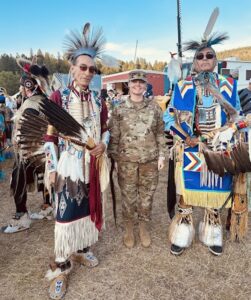
Story by Ayan Sheikh
DC National Guard
FORT BELKNAP AGENCY, Mont. – Under the vast Montana sky, where horses and buffalo graze on tall prairie grass, 17 members of the District of Columbia Army National Guard Medical Detachment participated in a joint mission providing healthcare services to the Fort Belknap Reservation community and their pets in August.
The multi-day mission also involved U.S. Army Reserve soldiers from the 7350th and 7360th Veterinary Detachments, as well as the Minnesota Army National Guard’s 148th Fighter Wing. This was the DCARNG Medical Detachment’s first participation in Operation Walking Shield Innovative Readiness Program (IRT), a real-world mission led by the Montana Army National Guard in collaboration with the Fort Belknap Indian Health Service.
“Serving the community of the Fort Belknap Reservation was a unique and invaluable training experience both for the participating soldiers and for the community,” said Capt. Supriya Davis, U.S. Army Emergency Physician.
The IRT mission adds value and reduces costs by combining military contributions with community resources. Typically, communities provide materials and essential services like facilities, while military units offer personnel and training expertise. These operations not only prepare forces for future missions but also strengthen civil-military partnerships and enhance community resilience.
Residents of the Fort Belknap Reservation received $1.6 million worth of free services, including primary care, optometry, health exams, dental care, veterinary services, and public health education.
The service members also gained insights into the challenges faced by rural communities in accessing lifesaving medical services. For instance, rural areas often have fewer healthcare providers and specialized care options, and residents must travel long distances to reach medical facilities. The presence of military medical detachments like DCARNG serves as a bridge to this significant gap.
“Being part of the DCARNG, most of our service members are used to serving inner-city and metropolitan communities,” Capt. Davis noted. “It takes a completely different mindset and approach to treat members in a rural community.”
She also highlighted that the experience medical personnel gained in Montana was valuable in preparing them for future deployments in resource-constrained environments.
“Our mission allowed 353 additional patients to be seen in the medical, dental, and optometry clinic than would otherwise have been able to be supported during our 8 days of clinical operations.”
Veterinarians provided wellness checks, performed spay and neutering procedures, and offered dental cleanings for over 100 community cats and dogs.
“Most people might be surprised that we offer veterinary care, but it’s important to highlight that we provide exceptional services, including rabies vaccinations,” said CW2 Jeffery Saenz, 7360th Veterinary Detachment, U.S. Army Reserve.
CW2 Saenz also expressed pride in serving the Fort Belknap Indian Reservation community, emphasizing the unity and shared purpose between the military and the local community.
“We always want to give back to local communities in any way we can, and this also benefits our soldiers,” he said.
Capt. Davis underscored that serving a historically marginalized community while in uniform reinforces the importance of the Army Medicine’s slogan “One Team…One Purpose! Conserving the Fight Strength Since 1775!”
“It makes me proud to wear the American flag on my shoulder,” she explained. “Moreover, the Native American community has a rich history of serving in the U.S. Army, a fact that was highlighted when they specially honored veterans during the opening night of the annual Hays Powwow.”
The Hays Powwow is an annual cultural event held in Hays, Montana, on the Fort Belknap Indian Reservation. It is a significant gathering for Native American communities because it is celebrating their culture, traditions, and heritage. The powwow typically features traditional dance, music, and ceremonies, and provides an opportunity for both Native American and non-Native American participants to engage with and learn about Native cultures.
Military medical personnel were invited to participate in the powerful experience—it deepened their understanding of a population that is integral to our nation’s history.
Additionally, the presence of medical service members at Fort Belknap Reservation strengthened the community’s healthcare infrastructure and fostered better understanding of the scope of Department of Defense mission.